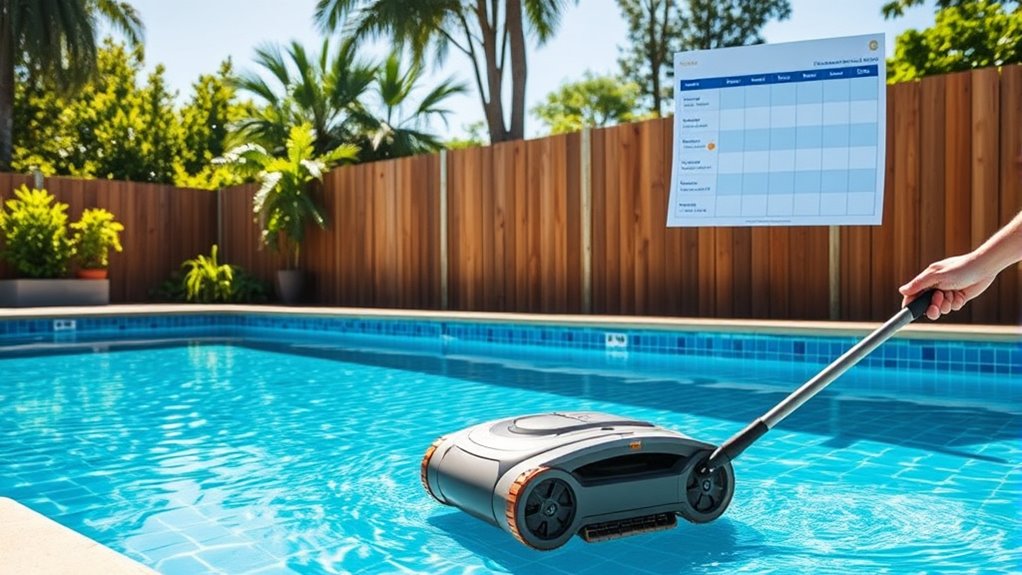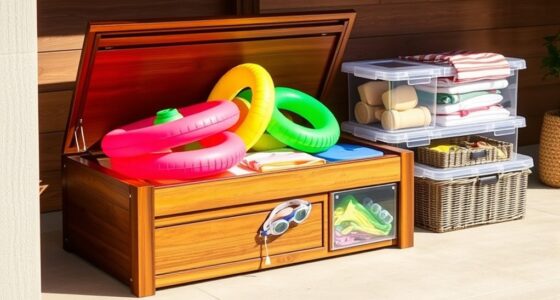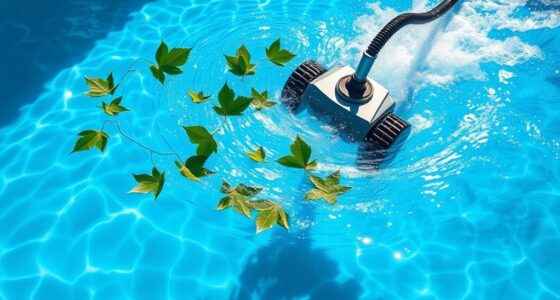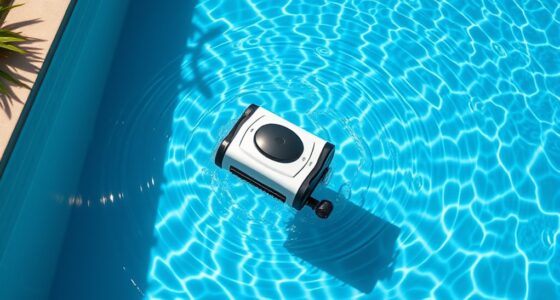To keep your pool spotless, balance automatic cleaners with manual tasks. Daily, check chemical levels, skim debris, and run your automatic cleaner to prevent buildup. Weekly, brush walls, vacuum the floor, and empty baskets. Monthly, test water chemistry and do a deep clean, inspecting equipment for wear. Properly storing gear and maintaining equipment prolongs its life. Mastering this schedule makes pool upkeep easier—keep going, and you’ll discover how to customize your perfect routine.
Key Takeaways
- Assess pool size, features, and water chemistry to determine appropriate automatic and manual cleaning tools.
- Implement daily maintenance with automatic cleaners and water testing for consistent chemical balance.
- Schedule weekly manual cleaning tasks like brushing, vacuuming, and debris removal for thorough cleanliness.
- Perform monthly water testing, chemical adjustments, and deep cleaning to maintain optimal water quality.
- Regularly inspect and maintain equipment, balancing automated systems with manual interventions for efficient upkeep.
Assessing Your Pool’s Needs and Equipment
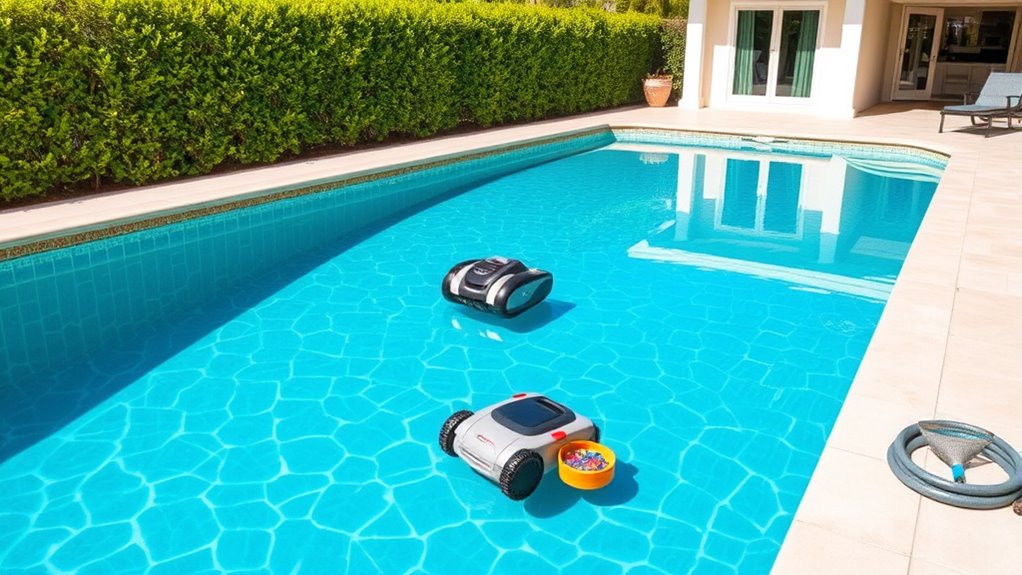
Before creating a cleaning schedule, you need to evaluate your pool’s specific needs and the equipment you have. Start by checking your pool’s current chemistry, including pH, chlorine levels, and alkalinity. Proper pool chemistry ensures safe swimming conditions and prevents damage to your equipment. Knowing your pool’s size and filtration system helps determine the right cleaning tools and frequency. Consider safety precautions, like ensuring electrical outlets and equipment are properly grounded, and that safety covers are in place. Assess whether your pool has features like a skimmer, vacuum, or automatic cleaner, which can influence your cleaning routine. Understanding pool chemistry and how it affects water quality can help you make informed decisions about maintenance routines. Additionally, assessing the performance metrics of your cleaning equipment, such as suction power and filtration efficiency, can ensure optimal operation. Regularly monitoring filtration system performance and making necessary adjustments will help maintain water clarity and reduce the need for manual cleaning. Recognizing the impact of equipment efficiency on overall pool maintenance can further streamline your cleaning schedule. Leveraging AI-powered diagnostics can also enhance your ability to optimize equipment performance and detect issues early. By understanding these factors, you’ll be better equipped to develop an effective, tailored cleaning schedule that maintains water quality and protects your investment.
Daily Maintenance Tasks for a Healthy Pool

Maintaining a healthy pool requires consistent daily attention to key tasks that guarantee water clarity and safety. Start by using your pool cleaning robots to remove surface debris and prevent buildup. Next, check your chemical testing kits daily to monitor pH and chlorine levels, ensuring proper sanitation. Keep skimming the surface for leaves and insects, preventing algae growth. Also, inspect and clean your skimmer and pump baskets to maintain ideal circulation. Regularly testing and adjusting chemicals helps keep water balanced and safe. Additionally, incorporating essential oils for water treatment can enhance water quality and provide a natural approach to maintaining a fresh pool environment. Understanding Automated cleaning systems can further streamline your routine and reduce manual effort. These daily tasks are simple but vital for preventing bigger problems down the line, helping you maintain a pristine, healthy pool with minimal effort. Staying on top of these essentials ensures your pool stays inviting all season long. To support your pool maintenance routine, consider creating a digital reminder system to track your daily tasks and ensure nothing is overlooked. Incorporating proper chemical balance is also crucial for preventing issues like algae and bacteria buildup, ensuring your water remains crystal clear. Additionally, using air purifiers in indoor pool areas can help reduce airborne contaminants and maintain a healthier environment around your pool space.
Weekly Manual Cleaning Techniques

Wondering how to keep your pool sparkling beyond daily tasks? Weekly manual cleaning is essential. Start with pool skimming to remove leaves, insects, and debris floating on the surface, preventing clogging and water discoloration. Next, focus on algae removal by brushing the pool walls and tiles thoroughly; this helps prevent algae buildup and keeps your water clear. Check your skimmer and pump baskets, emptying them to make certain proper filtration. Use a pool vacuum to clean the bottom and corners, especially if debris has settled. Regularly inspecting and maintaining your pool’s surfaces and equipment helps reduce chemical imbalance and prolongs the life of your pool. Incorporating proper cleaning techniques can enhance the effectiveness of your routine and ensure a pristine swimming environment. Additionally, paying attention to astrological signs related to water elements can offer insights into optimal cleaning times for some enthusiasts. This weekly routine keeps your pool inviting, clean, and safe for swimming.
Setting Up and Using Automatic Cleaners Effectively

Setting up your automatic pool cleaner correctly is key to making sure it works efficiently and keeps your pool spotless. Proper setup helps prevent issues with pool chemical safety and maximizes the cleaner’s effectiveness. To get started, ensure the cleaner is compatible with your pool size and shape. Regularly check and clear debris from filters and brushes. Use outdoor cleaning tools to remove stubborn dirt before starting the cleaner. Keep an eye on the cleaner’s navigation to avoid missed spots. Also, review manufacturer instructions for optimal operation. Proper setup reduces strain on your pool’s chemicals and helps maintain safe chemical levels. Additionally, understanding the energy efficiency of your equipment can contribute to lower operational costs. Ensuring your system has proper insulation can further improve efficiency and performance. Being aware of automatic cleaner maintenance can extend the lifespan of your device and improve its performance. Regularly inspecting and cleaning your equipment can also help prevent mold or spoilage, which could affect the cleaner’s operation and your pool’s water quality. Recognizing the importance of suspension upgrades can improve the cleaner’s maneuverability across different pool surfaces. By following these steps, your automatic cleaner will perform better, saving time and effort in maintaining a pristine pool environment.
Monthly Water Testing and Chemical Balancing

Each month, you should test your pool water parameters to make certain everything is balanced. Adjust chemical levels as needed to maintain clarity and safety. Keep an eye on pH stability to prevent issues and keep your pool in top shape. Regular testing of water quality helps identify air quality concerns that could affect your pool environment. Incorporating proper water testing techniques ensures accurate readings and effective adjustments, contributing to a healthier pool. Utilizing automation in testing methods can streamline this process and reduce manual effort. Additionally, understanding the impact of chemical balancing on water quality can help prevent corrosion or scaling issues. Regular monitoring also helps detect contaminants, ensuring that your pool remains safe and inviting for swimmers.
Test Water Parameters
How often should you test your pool water? At least once a month, you should perform a water test to guarantee proper chemical balance. Regular testing helps you catch issues early and maintain crystal-clear water. When testing, focus on key parameters like pH, alkalinity, calcium hardness, and chlorine levels. Keep an eye on these to prevent algae growth and equipment damage. Utilizing expert voice actors in your testing instructions can make the guidance more engaging and trustworthy. Additionally, staying aware of indoor air quality can help prevent issues caused by airborne pollutants that may affect your pool area. Regularly monitoring your water parameters also supports the preservation of your pool’s environmental balance, which is vital for long-term maintenance. To make this process easier, remember:
- Use a reliable water test kit for accurate readings
- Record test results for future reference
- Adjust chemicals based on test outcomes
- Re-test after chemical adjustments to confirm balance
Consistent testing keeps your pool safe and inviting, ensuring your water stays perfectly balanced with minimal effort.
Adjust Chemical Levels
Regularly adjusting your chemical levels based on your water tests guarantees your pool remains safe and inviting. Start by checking the pH level; if it’s too high or low, perform a pH adjustment using appropriate chemicals to bring it within the ideal range of 7.2 to 7.6. Proper chemical balancing also involves checking chlorine levels and alkalinity, ensuring they stay within recommended ranges. If chlorine is too low, add sanitizer to prevent algae growth and bacteria. If alkalinity is off, adjust with specific chemicals to stabilize pH and chlorine effectiveness. Consistent chemical balancing helps maintain clear, healthy water and reduces strain on your filtration system. Making these adjustments monthly keeps your pool in top condition and minimizes the need for costly repairs.
Monitor Ph Stability
To maintain stable pH levels and guarantee your chemical balance stays consistent, it’s important to monitor your pool’s pH regularly through monthly water testing. This helps prevent pH fluctuation, which can lead to cloudy water and equipment issues. Consistent testing allows you to detect changes early and adjust your chemicals accordingly, ensuring chemical stability.
- Use a reliable test kit or digital meter for accurate readings
- Record your pH levels to track trends over time
- Adjust chemicals promptly to prevent pH swings
- Check alkalinity and stabilizers, as they influence pH balance
Seasonal Deep Cleaning and Equipment Checks
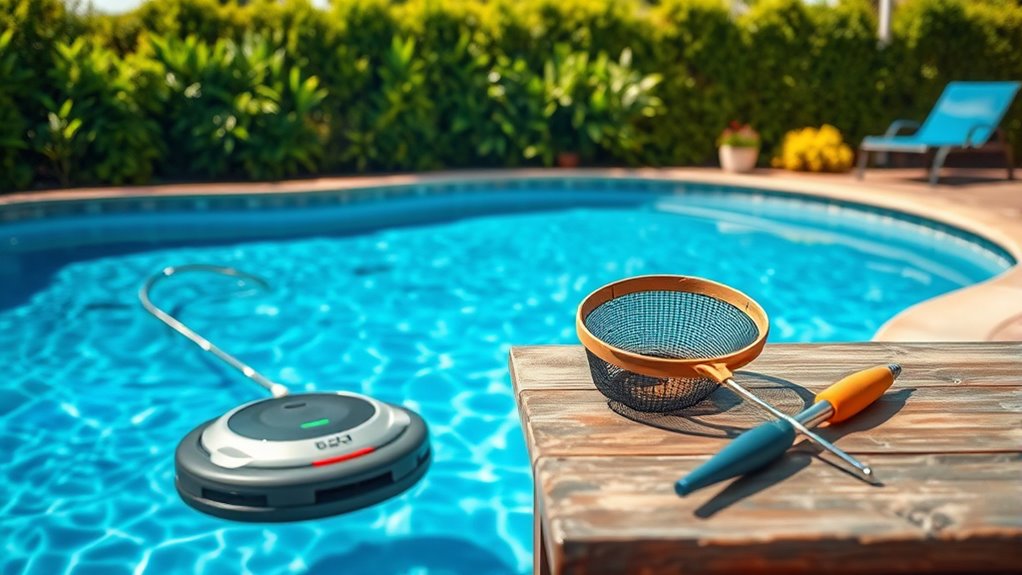
As the seasons change, it’s vital to perform a thorough deep clean of your pool and inspect your equipment to guarantee everything functions properly. Start by draining and cleaning the pool surface, walls, and floor to remove algae, dirt, and debris. Check your pool filters, pumps, and skimmers for wear and tear, replacing parts as needed. This is also a good time to review your pool chemicals and ensure your sanitizer levels are balanced, preventing any health risks. Always follow safety precautions when handling chemicals or inspecting equipment to avoid accidents. Additionally, clean your pool’s circulation system to maintain proper water flow. Regular seasonal checks keep your pool in top shape, prolong equipment lifespan, and ensure safe, enjoyable swimming all season long.
Troubleshooting Common Pool Cleaning Issues

If you notice algae growing in your pool, try shocking the water and brushing the affected areas regularly. Blocked filters can reduce circulation and clarity, so check and clean them often. Equipment malfunctions might require inspecting pumps or skimmers for proper operation to keep your pool clean and safe.
Algae Growth Solutions
Have you noticed green or cloudy patches forming on your pool’s surface? Algae growth is common but manageable with the right approach. To combat it, consider eco-friendly cleaning and DIY solutions that are safe for your family and the environment. Here are some effective strategies:
- Use eco-friendly algaecides to eliminate algae without harsh chemicals
- Regularly brush pool walls and floors to prevent algae buildup
- Maintain proper chlorine levels to inhibit algae growth
- Shock your pool with a chlorine boost to kill existing algae
These steps help control algae naturally and prevent future outbreaks. Consistent maintenance is key to keeping your pool crystal clear and inviting, all while keeping eco-friendly practices in mind.
Filter Blockages Fixes
Filter blockages can considerably hinder your pool’s circulation and filtration efficiency, leading to cloudy water and debris buildup. To fix this, start by inspecting your filter for debris or clogs. Remove the filter cartridge or mesh and clean it thoroughly with a hose. For sand or diatomaceous earth filters, backwash according to your manufacturer’s instructions. Regular pump maintenance helps prevent blockages by ensuring the system runs smoothly. Check for any obstructions in the skimmer and pump baskets, and clear out debris as needed. If you notice persistent filter blockages, consider replacing worn or damaged filter parts. Keeping your filter clean and performing routine pump maintenance ensures ideal water flow and keeps your pool crystal clear.
Equipment Malfunction Tips
Equipment malfunctions can disrupt your pool cleaning routine and lead to poor water quality. When issues arise, start by checking equipment calibration to guarantee your automatic cleaners are functioning correctly. Poor calibration can cause incomplete cleaning or equipment failure. Next, troubleshoot the power supply—inspect cords, outlets, and switches for damage or loose connections. If your device isn’t turning on, resetting or replacing components may be necessary. Also, verify that filters and pumps aren’t clogged, which can impair operation. Consider these tips:
- Confirm proper equipment calibration for accurate cleaning
- Check power supply connections and reset tripped breakers
- Inspect cords and plugs for damage
- Clean or replace clogged filters and pumps
Addressing these common issues promptly keeps your pool clean and your equipment running smoothly.
Tips for Integrating Manual and Automated Methods
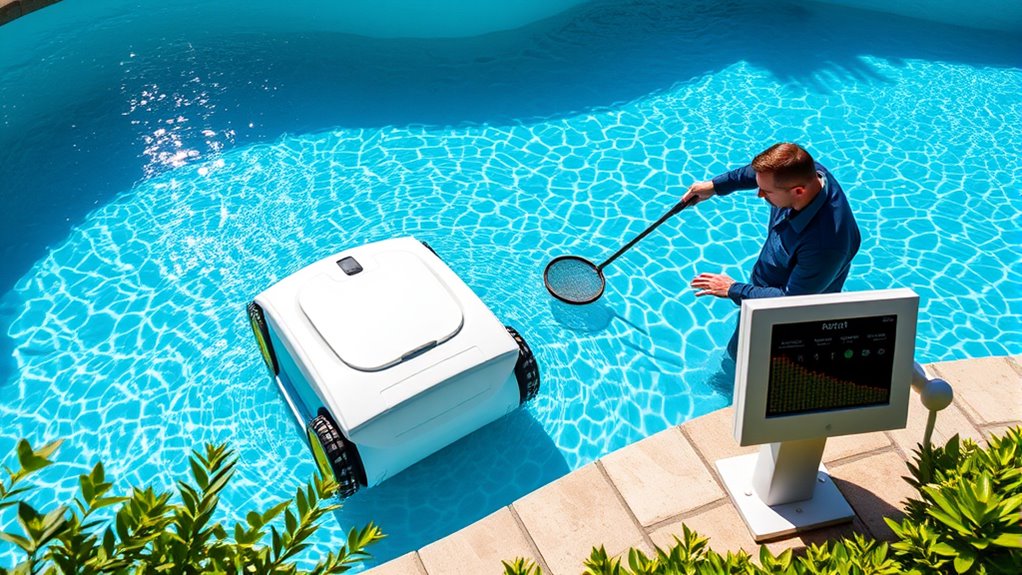
To effectively maintain a clean and healthy pool, blending manual and automated cleaning methods is essential. Start by using manual techniques for detailed tasks like scrubbing corners, cleaning filters, and removing debris that automation might miss. Automation integration streamlines routine maintenance, such as robotic cleaners or automatic skimmers, but doesn’t replace the need for manual oversight. Schedule regular manual inspections to catch issues early and ensure equipment functions properly. Coordinate your manual efforts with automated tasks so they complement each other—run robotic cleaners after manual brushing or vacuuming. This balance prevents over-reliance on automation, reduces equipment strain, and keeps your pool sparkling. Consistent communication between manual and automated methods helps you maintain ideal water quality with minimal effort.
Creating a Personalized Cleaning Schedule

Developing a personalized cleaning schedule guarantees your pool stays pristine with minimal effort. Tailoring your routine ensures you enjoy more poolside relaxation and maintain chemical safety. Consider factors like pool usage, weather, and equipment when planning your schedule.
- Set specific days for skimming, brushing, and vacuuming
- Adjust chemical levels regularly based on usage and weather
- Incorporate weekly tests to monitor water balance
- Use automated systems efficiently alongside manual cleaning
Maintaining Equipment for Longevity and Performance
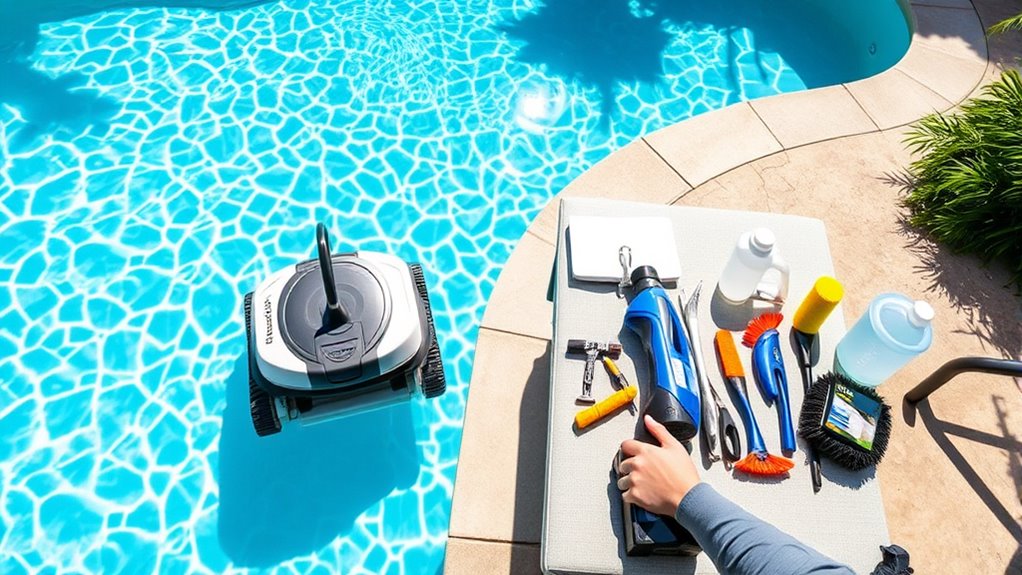
To keep your pool equipment running smoothly, you need to regularly inspect your gear for signs of wear or damage. Proper storage when not in use helps prevent corrosion and extends the life of your tools. Staying on top of these practices guarantees your equipment performs well and lasts longer.
Regular Equipment Inspection
Regular equipment inspection is essential for keeping your pool in ideal condition and ensuring it performs reliably over time. By regularly checking your equipment, you can catch issues early and prevent costly repairs. Focus on maintaining proper pool chemistry to avoid strain on your equipment. During inspections, look for signs of wear, leaks, and corrosion. Regular equipment maintenance helps extend the lifespan of filters, pumps, and heaters. Keep an eye on:
- Pump and filter operation
- Hoses and connections for leaks
- Chlorinator and skimmer functionality
- Overall cleanliness and corrosion signs
Addressing small problems promptly will save you time and money down the line. Consistent inspections ensure your pool stays balanced, safe, and ready for use, making your cleaning schedule more effective.
Proper Storage Practices
Proper storage practices are essential for preserving your pool equipment’s longevity and ensuring ideal performance. Store equipment in a clean, dry area to prevent rust and damage. Properly organize your tools and supplies to avoid clutter and make maintenance easier. When it comes to pool chemical storage, keep chemicals in a cool, well-ventilated space, away from sunlight and incompatible substances. This prevents deterioration and safety hazards. Use labeled containers and sturdy shelving to maintain equipment organization, reducing the risk of accidents.
| Aspect | Best Practice |
|---|---|
| Pool Chemical Storage | Store chemicals in a cool, dry, ventilated area |
| Equipment Organization | Use labeled bins and shelves for easy access |
| Equipment Longevity | Keep equipment clean and dry after use |
| Damage Prevention | Cover and store in protected areas |
| Safety Measures | Keep chemicals away from children and pets |
Frequently Asked Questions
How Do I Choose Between Manual and Automatic Pool Cleaners?
When choosing between manual and automatic pool cleaners, consider your pool size and debris. If you prefer convenience, a robot vacuum can handle most cleaning tasks, saving you time. However, manual skimming is useful for quick, targeted cleanings or hard-to-reach spots. You might find that a combination of both gives you the best results, ensuring your pool stays pristine with minimal effort.
What Are Signs My Pool Needs More Frequent Cleaning?
Your pool whispers when it’s craving extra attention. If you notice murky water, lingering debris, or an imbalance in pool chemical balance, it’s time to act. Algae prevention becomes a battle you shouldn’t lose, and frequent cleaning helps keep your water crystal clear. Cloudy water, foul odors, or algae blooms are signals that your pool needs more frequent cleaning, so stay vigilant to keep your oasis inviting and pristine.
Can I Use Manual and Automatic Cleaners Simultaneously?
You can definitely use robotic vs manual cleaners at the same time to keep your pool spotless. While the robotic cleaner handles debris and dirt automatically, manual cleaning lets you target spots robots might miss. Just guarantee you maintain proper chemical balancing to prevent algae and bacteria growth. Using both methods together maximizes efficiency, keeps your water clear, and reduces overall cleaning time, making pool maintenance easier and more effective.
How Do Weather Changes Affect My Pool Cleaning Schedule?
Weather changes considerably impact your pool cleaning schedule. During seasonal pool maintenance, heavy rain or wind can introduce debris, requiring more frequent manual cleaning. Hot weather increases algae growth, so you’ll need to check chemical levels more often. Consider weather impact considerations to adjust your routine accordingly. Using automatic cleaners can help manage debris after storms, but manual cleaning remains essential during extreme weather to keep your pool sparkling.
What Safety Precautions Should I Follow During Cleaning?
While it’s tempting to dive right in, prioritize your safety during pool cleaning. Always follow pool chemical safety guidelines to prevent mishaps, like accidental chemical contact. Remember electrical safety tips—avoid working near electrical outlets or equipment with wet hands. Use proper tools and protective gear to safeguard yourself. Staying cautious not only keeps you safe but also ensures your pool stays sparkling and inviting for everyone to enjoy.
Conclusion
By blending manual finesse with automated efficiency, you craft a symphony of pristine waters that beckon like a shimmering oasis. Regular attention and smart equipment use turn your pool into a crystal-clear sanctuary, where every splash feels like perfection. Keep the rhythm steady, and your pool will mirror the elegance of a well-conducted masterpiece—an inviting retreat that reflects your dedication and care. Plunge in with confidence, knowing your schedule keeps the magic alive.
